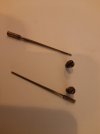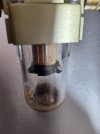Objective
Member
Another gotcha.
We have a bent needle in the rear carb (1971 2000TC) and a replacement ready. On our twin SU HS8 carbs, can i release the (brass?) grub screws from the dashpot pison (nos. 19 and 21 in the WSM) holding the needle secure in the piston . . . nope.
The screw has already resisted previous attempts and its single slot is a little 'rounded'. The deep well where the screw is located has been bathed in WD40 - no joy. My impct hammer (luckily) hasn't got the reach to get down into the well and locate on the screw head. Ive applied some heat, but still no joy.
I have a garage, some suitable tools and few facilities locally. I could take it to one of the garages locally, but I'm concerned the piston itself could get scored or dinked by over-zealos vice-work.
Has anyone got suggestions ?
We have a bent needle in the rear carb (1971 2000TC) and a replacement ready. On our twin SU HS8 carbs, can i release the (brass?) grub screws from the dashpot pison (nos. 19 and 21 in the WSM) holding the needle secure in the piston . . . nope.
The screw has already resisted previous attempts and its single slot is a little 'rounded'. The deep well where the screw is located has been bathed in WD40 - no joy. My impct hammer (luckily) hasn't got the reach to get down into the well and locate on the screw head. Ive applied some heat, but still no joy.
I have a garage, some suitable tools and few facilities locally. I could take it to one of the garages locally, but I'm concerned the piston itself could get scored or dinked by over-zealos vice-work.
Has anyone got suggestions ?





